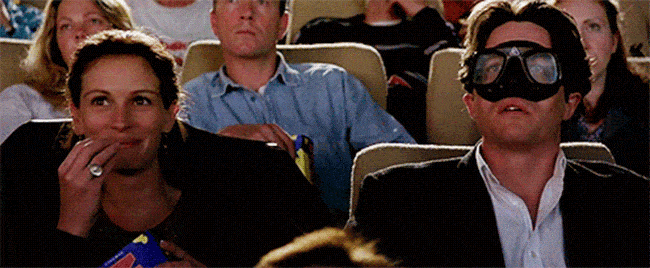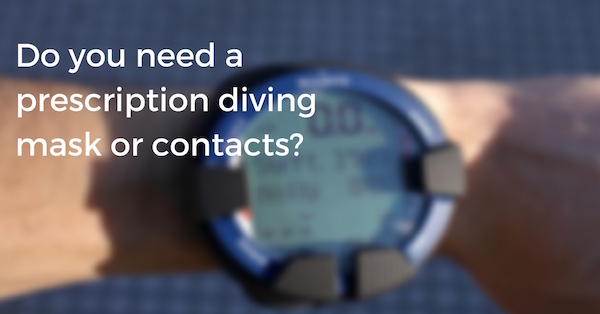Your guide to prescription diving masks and diving with contacts
When I first started writing this article about prescription diving masks, the thing that stood out in my mind was that famous scene in the movie Notting Hill. You know the one I mean: Hugh Grant can’t find his glasses, so he goes to the cinema with his prescription snorkel mask instead.
That was the first time I ever realized you could even get prescription items that weren’t just regular glasses. It never occurred to me that you could order items like prescription scuba masks, ski, and prescriptive swimming goggles.
In fact, I couldn’t be more grateful to Hugh Grant and that infamous scene because five years later, when I explored the Great Barrier Reef, I was glad to have a clear vision and be able to enjoy the incredible views properly!

When I then started looking around for options, I was amazed by the choices. I had thought the only option would be prescription dive goggles, but there are quite a few other options like scuba diving with contact lenses for example.
Scuba diving with contact lenses has become the choice of many divers lately, since it is quick and convenient, and if you wear your contacts anyway, it is the easiest and most convenient choice.
Can you wear contact lenses while scuba diving?
Yes, you can wear contacts while diving, but there are a couple of things you should keep in mind. With contact lenses, you have to be more careful when it comes to flooding your mask. It does happen as you probably know, and you have to remember to keep your eyes closed while clearing your mask not to lose your contacts.
You can lose contact lenses fairly quickly when scuba diving. They’re only held in place by suction after all. No one likes the idea of becoming visually impaired underwater, as in some cases it may mean ending the dive and relying on your buddy to get you back to the boat or shore.
Hard contact lenses are rigid, and no gas exchange can take place. So after the dive or during ascent you might experience issues with the gas transfer since hard lenses do not allow gas to pass through the lens, and thus there might be bubbles from the nitrogen escaping the eye, and blurred vision after the dive.
Added to this you can end up with dry eyes, which can be more than a little irritating. Since hard contact lenses are usually smaller than soft contact lenses, they have less suction and are easier to lose. In general, if you want to use contact lenses, I would recommend scuba diving with soft contact lenses!
[the_ad_group id="1249"]
Scuba diving with contact lenses works best with soft lenses since they are gas permeable
Soft contact lenses permit the transfer of gas from the eyes, so there is no visual impairment after the dive due to escaping nitrogen. They are also larger and not so liable to float away immediately on immersion in water, your eyelid should cover enough of it to prevent this, especially if you close your lid slightly.
Soft contacts are more comfortable for a new or infrequent wearer, and if you go for the daily lenses they are easy to care for, just remove after use and choose a new pair the next time you dive. The advantage of diving with contact lenses to correct your vision is that you can still see when you take your mask off after the dive and it is easy to handle since you put them in every morning anyway.
You should, however, be aware of a slightly higher risk of eye infection if you wear contact lenses underwater. They can become contaminated by bacteria in the water plus they could absorb the defogging solution you use whether it is a proprietary brand defogger, toothpaste, washing up liquid, or like I use, baby shampoo. With soft lenses it is best to stick to defogging with good old fashioned spit and discard daily lenses after wear, to be on the safe side.
With the daily disposable lenses, you just get a fresh pair every day so it’s easy to deal with, but the long wear lenses will need extra careful cleaning and disinfecting between dives! Daily disposable lenses cost from around $25 a month, but you should always have the optician check your eyes to assess suitability and fit before you buy any.
Prescription diving masks

Of course, if you can’t wear lenses or do not like the option of lenses since you usually wear glasses, you’ll want to have a look at the various kinds of prescription dive masks. This is a growing market, fueled by our ever-expanding horizons and the availability of all sorts of water based activities at home and abroad and there are plenty of companies catering to it.
Depending on your prescription you’ll be able to get away with an off the rack standard dive mask with corrective lenses, stick on prescription lenses or you’ll go for the bespoke made to order prescription which can also correct astigmatism and can include bifocals too.
A bifocal dive or snorkel mask could even be an option as you lose your close up vision due to age, it happens to most of us eventually, and after all, you can continue diving for as long as you have your health.
Having a bifocal dive mask means you could continue to see gems like ghost shrimp cleaning a moray eel or hiding in the anemone with the clownfish. Getting a mask made to your exact prescription is not the cheap option, but with proper care masks last for years and whatever you spend on one will repay you with clear vision underwater for a long time.
[the_ad_group id="1250"]
How to buy prescription scuba goggles?
Suitable prescription scuba goggles with simple off the shelf correction lenses will set you back around $100. In the more typical online shops like Amazon, you might find deals starting from $39.95 plus postage for a mask with your choice of lenses. Lenses are priced separately from the mask, so you need to choose a mask and then a right and left lens for that mask.
Some companies will sell you their masks and lenses separately so if your prescription changes you can change the lenses, you can order the lens and fit it yourself, although feedback suggests it may be easier to return the mask to allow them to fit the new lens for you. Most brands of masks can be fitted with prescription lenses, Mares, Hollis, Tusa, Aqualung, and Atomic for example.
Also read: 6 Helpful Tips To Help you Prevent Your Scuba Mask from Leaking
Try a few masks to find the right fit before fitting the prescription lenses
Your local dive shop or diving center should be able to advise you on adjusting your mask. For a more complex prescription, you can have a mask with made to order lenses. Send in your prescription from your Optician, and they will make your lenses and fit them into the mask ready to use. Prices start from $225 including a Mares X-Vision mask but prices vary for other types of masks You could also have lenses fitted into your existing mask. This would be $190 for a simple prescription. For Bifocals add $80 and for Franklin Split Bifocals, add $140.
[the_ad_group id="1251"]I like the convenience of a bifocal prescription mask, but it can be pricey. The cheaper alternative is stick on bifocal lenses. They come in varying magnifications to suit your eyesight. Hydrotac Stick-On Bifocals are sold for $20 on Amazon and the reviews are pretty good.
Oh, and in case you want to have a dive holiday off the beaten track, it might be a good advise having a spare mask with your prescription, since in case you lose or break your mask, it might otherwise mean the end of your dives on that holiday!
What are your thoughts about Scuba Diving with Prescription Glasses or Contacts? What do you prefer? Let us know in the comments below.
This article is written by RUSHKULT, the online booking platform for Scuba Diving. Visit the RUSHKULT platform to book your next Scuba Dive training, guided trip, and accommodation. [the_ad id="10253"]
Leave a Comment